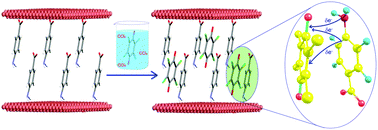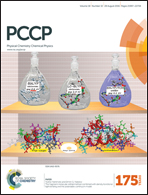Spectroscopic and computational investigations on the origin of charge transfer between included neutral guest molecules and a functionalized anionic layered host†
Abstract
Layered double hydroxides (LDHs) or anionic clays are an important class of ion-exchange materials, well known for drug and gene delivery and several other applications including catalysis, bioactive nanocomposite, electroactive and photoactive materials. Their structure is based on positively charged brucite-like inorganic sheets with the interlamellar space being occupied by charge-compensating exchangeable anions. In spite of having a vast scope many of the applications of LDHs are restricted as their host–guest chemistry is limited to ion-exchange reactions. Recently we have shown for the first time that charge-transfer interactions can be used as a driving force for the insertion of neutral guest molecules (ortho- and para-chloranil) within the galleries of an Mg–Al LDH by forming a charge-transfer complex with aniline pre-intercalated as p-aminobenzoate anion. Here, we have performed quantum chemical calculations in combination with molecular dynamics simulations to elucidate the nature of interactions, arrangement and the evaluation of electronic and Raman spectral signatures of the chloranil charge-transfer complex included within the galleries of the Mg–Al LDH. The natural bond orbital (NBO) analysis has been used to understand the nature and origin of the unidirectional charge-transfer that lead to the unusual insertion of chloranil in the galleries of the Mg–Al LDH. The NBO analysis reveals that a considerable amount of electronic charge redistribution occurs from the p-aminobenzoate to the chloranil during latter's insertion within the LDH galleries with a very negligible amount of back donation. This work is expected to pave the way for understanding the host–guest chemistry and targeted and controlled delivery of poorly soluble drugs.



 Please wait while we load your content...
Please wait while we load your content...